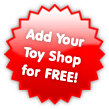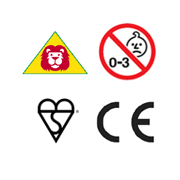


Although the various initiatives introduced by governments and toy associations means that the toys our children play with are safer than ever before, there is still a need for parents to be vigilant and aware of the various hazards that certain toys may pose to young children.
Many of the checks that parents should perform when choosing safe toys for their child require little more than common sense, although various logos showing age warnings and signs of conformity to certain safety standards are there to make this process even easier.
Click on each of the headings below to find out more about the most common symbols you are likely to find on the toys you buy. Alternatively, scroll down the page to find a few extra tips on what you can do to ensure the best toy safety standards in your home.

Introduced to promote high safety standards throughout the toy industry, this bright red and yellow symbol helps consumers to identify toys that are safe for children to use.

Launched in 1991, the Approved Lion Mark Retailer Scheme can only be used by members of the Toy Retailers Association to show that their toys conform to the EN 71 safety standard.

This symbol is used by toy manufacturers to show that their products meet all the relevant consumer safety, environmental or health requirements of the European Directive.

The red and white symbol first appeared on toys in 1995 and is used to show that the toy is unsuitable for children that are younger than three years old.

A partnership between BTHA and Bureau Veritas, Toyograph is a tool to help the toy industry with the chemical compliance required from July 2013.

Awarded by the British Standards Institution, the Kitemark symbol is considered a sign of reliability and safety - and can be found on all kinds of products, services and processes as well as some toys and outdoor play equipment.
Whilst the toy safety symbols shown above provide very good gauges of how safe a toy is for your child, there are lots of other very simple checks you can make yourself to enhance their usefulness. In particular, we recommend considering:
Toy size
In terms of toy safety, toys that are both too large and too small can pose risks. The most obvious thing to check for is whether there are any choking hazards. Babies and toddlers shouldn't be given any toy that is smaller than (or has individual parts smaller than) mouth-size. Similarly though, toys such as bicycles and other outdoor toys that are too large for the child can easily lead to unnecessary accidents and falls.
Age suitability
Whilst the 'Age Warning' mark is there to show what toys are suitable for the under 3s and which are not, all children develop at different speeds so it is important to also take your own child's ability into account.
Sharp edge
It is important to regularly check toys to ensure that they do not have any broken parts or sharp edges that could cause your child harm.
Cleanliness
Although this is especially important for babies and toddlers who tend to chew and suck any toy they are given, keeping toys clean is also especially important for outdoor toys (such as bikes and swings).
Tidiness
We all know that putting away a room full of toys when you know they are going to be strewn all over the floor again the next day can often seem pointless, but toys can pose serious tripping hazards so should be stored as tidily as possible. Similarly, ensure that toys are not stored in places that might cause your child harm when trying to find them (i.e. a high shelf).